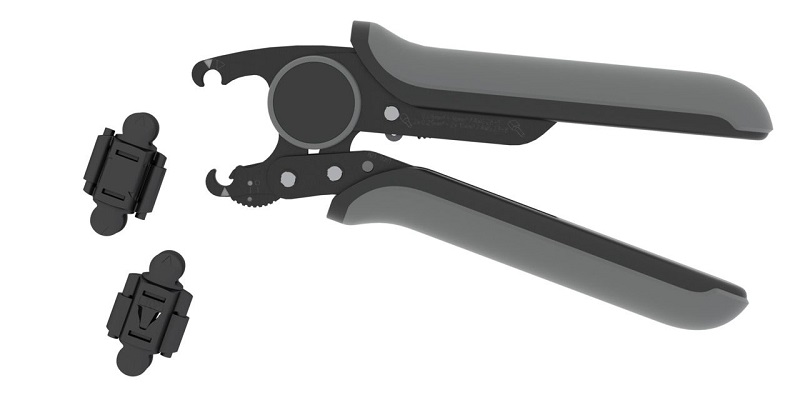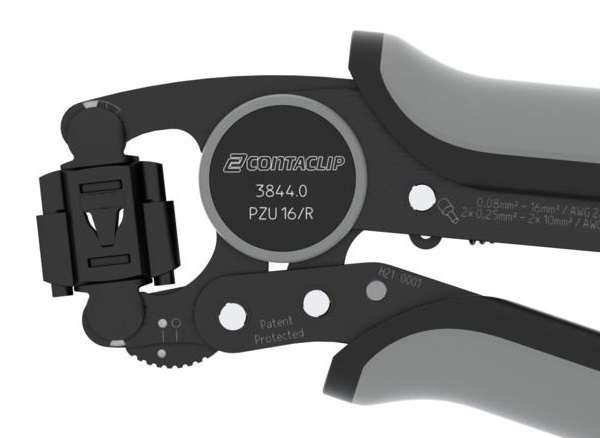Ferrule Crimping Tool from ContaClip With Adjustable Dies
ContaClip releases a new take on ferrule crimping with a tool that has interchangeable crimping inserts and a rotational ability to reach wires for proper repairs in nearly any difficult location.
If you compare the wiring in a control cabinet to the wiring done in a test bench lab, you might find one key difference: nearly every wire in the control panel will have a little metal cap, called a ferrule, crimped onto the end of the wire. A ferrule is a small metal tube, sometimes made with plated copper, that fits over the bare conductors and usually includes a plastic sleeve to prevent sharp bend angles that can crack stranded wires.
The metal tube part of the ferrule is crimped using a special tool that places pressure on several locations along the length of the tube, unlike the way you might crip a splice or ring terminal with typical wire crimpers. The crimp tool folds the metal along the tube, crushing (but not cutting) the conductors and securing the ferrule onto the wire.

The new ContaClip crimp tool. Image used courtesy of ContaClip
A ‘Ferrule-ly’ Important Part of Wiring
While this process may seem trivial, it is a very important part of the wiring process. Even though those six un-crimped wires you jammed into one terminal block back at the lab may seem to be working fine, the long service life of production equipment demands a better solution.
Recently, ContaClip has released a new kind of crimping tool that claims to be easier to use than previous models of crimping tools, showcasing the new model in time for the recent Hannover Messe automation trade show in Germany.

A ferrule applied to the end of a wire. Image used courtesy of Wikipedia
There are a couple of major reasons why ferrules are used in control panels. They allow for easy insertion into terminal blocks. Multi-stranded conductors have a tendency to be difficult to push in evenly, causing one or two strands to be left out of the terminal, potentially shorting to a nearby component. Another reason is for better connection with multiple conductors. Various wire gauges cannot be inserted into the same screw-down terminal; only the larger wire will maintain a secure bond. It’s important to have the right tools for the right connections.
ContaClip Crimping Tool
To properly crimp ferrules, you need a special crimping tool, and you may need different crimping tools for various ferrules and different-sized conductors. The new tool from ContaClip is made from high-strength steel with a coating on the high-stressed components. The crimper is designed to be ergonomic, durable, and designed for fatigue-free use.
What separates ContaClip’s crimper from other manufacturers is the ability to exchange the crimp tooling of the crimper with a square or trapezoidal crimp die set insert. Both are common, but usually, one tool will only have one crimp profile.
Another interesting feature is the ability to rotate the die inserts up to 360° in 45° increments. Being able to adjust the angle of the crimping face allows for a more ergonomic tool and to get at hard-to-reach spaces.

Close-up of the end of the crimp tool shows how the die pieces interface to clamp the ferrule securely down into the channel. Image courtesy of ContaClip
This single tool will crimp ferrules either with or without the plastic insulating collars, and will accept ferrules up to 18 mm long with a cross-section area of up to 16 mm^2 (up to 5 AWG). As for ferrules with twin sleeves, this crimp tool can handle ferrules from 2x0.25 mm^2 to 2x 10 mm^2.
The tool will automatically adjust to the cross-section diameter of the ferrule, so there is no pre-configuration or adjustment required. The handles are spring-loaded to reduce wear on the user from crimping ferrules all day.
Don’t Let Bad Tools Crimp Your Style
If you have ever spent time wiring control panels, you know there can be a lot of wires that require crimping. Depending on the size of the cabinet, there could be thousands of wires that need to have two ferrules, one for each end of every single wire. This process can have a lasting effect on the user, and it’s not uncommon for electricians and panel builders to develop carpal tunnel syndrome from crimping ferrules all day. Having good tools can reduce strain on workers in much the same way office staff needs proper ergonomic chairs and desks.
A lot of equipment builders and device manufacturers are turning to spring-loaded, or 'screwless' terminal blocks. This reduces stripped and lost screws which lead to service calls where a terminal screw wasn’t tight. By using properly crimped ferrules, the conductor can be easily pushed into the spring-loaded terminal. No screws to tighten and far fewer pesky late-night service calls that cost hundreds or thousands of dollars, all because the right tool wasn’t used.

 Facebook
Facebook Google
Google GitHub
GitHub Linkedin
Linkedin








